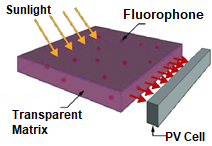Transparent solar panels are cutting-edge technology that gathers and uses light energy through a window or glass surface irrespective of the angle. Solar panels use transparent plain glass as panels.
The glass is coated and made of special materials to make it undergo a photovoltaic effect. So, the glass remains transparent but still converts solar energy into electrical energy. This gives an additional advantage of no land space or only the rooftop required for installation.
Solar panel cells absorb only the infrared and ultraviolet light from the electromagnetic spectrum of the light. Because of this, visible light passes through the cells unimpeded. It is done by coating the glass with a special salt. So, the invisible light is converted into electrical energy.
Working Principle
In the case of transparent luminescent solar concentrators or transparent solar panels, the radiation from a large surface is concentrated in a smaller area to improve the effectiveness of the solar cell generating electricity. Solar panels work by converting the radiation from a large area into a glowing luminescence smaller area which is directed towards a smaller area. Solar panel’s principle is basically concentrating the light and thus increasing the power density.
The conventional solar cell works on the properties of the n-type and p-type semiconductors.
Working of the transparent Solar panel
The primary components of the transparent solar panel are – the frame, glass, front adhesive film, solar cells, back adhesive film, back sheet, and junction box. The most important component of the transparent solar panel is the solar cell. The solar cell is also called a photovoltaic cell. The solar cell would generate electricity when sunlight strikes it, this is called the photovoltaic effect.
Multiple solar cells are used in the formation of a single solar pane because the power generated by one solar cell is very less. The other components such as – the frame, glass, front adhesive film, back adhesive film, and back sheet act as protection for the solar cells.
A solar cell is a semiconductor material like silicon. The solar cell is responsible for the generation of electricity. A solar cell has two silicon layers, one is the p-type semiconductor layer and the other is the n-type semiconductor layer. The n-type semiconductor layer faces sunlight and then releases electrons. The space created by these electrons is called holes.
These electrons are received by the p-type semiconductors which are placed below the n-type layer. Due to this flow of electrons, the current is generated which passes through the junction box. From the junction box, the final output current is obtained.
In some transparent solar cells, the glass is used as a luminescent solar concentrator. Organic salts that are complex cyanine derivatives are fused with the glass. Cyanine is a synthetic dye that is used as a fluorescent dye in biomedical imaging. Cyanine generally covers the IR and UV spectra.
Some particular salt derivatives of the cyanine dye are precipitated with the help of a reaction with a base. These particular salts are used to absorb the near-infrared and ultraviolet spectra simultaneously by allowing visible light to pass through them.
The cyanine derivative luminescence (emit) absorbs the energy in a different IR frequency which is channelized to the edge of the glass due to total internal reflection to the edges that have smaller surface area. These are lined with small-scale conventional photovoltaic solar cells. This then converts light into electricity.
Design and Construction
At first, the main component, that is the glass or the other substrate material is coated. Then a semiconductor layer is placed, similar to the conventional solar panels. This semiconductor layer will capture the light and convert it into electrical energy. After this, a circuit is connected. This circuit will transfer the electricity forward. Because of the transparent electrodes used, another UV layer can also be added to it. By this, more sunlight can be reflected and can be used to generate power. After this, an anti-reflective coating is used on both surfaces so as to reduce reflections.

If luminescent solar cells are used, they contain parallel sheets of normal plastic and dye-coated plastic. The sunlight would pass through the plastic and would be absorbed. The electrons from the dye are then excited by the addition of energy from the radiation. As a result of which the electron jumps to a higher level.
When these electrons fall back to their ground state, some energy is released in the form of radiation. This radiation is then reflected through the plastic sheet by the principle of total internal reflection. In total internal reflection, the light is reflected at an angle more than the critical angle, this is done from a transparent surface. Light rays are guided by total internal reflection to the small surface of the concentrator. Here it is absorbed by the conventional photovoltaic strip.
Solar concentrators are comparatively cheaper than solar trackers. This is probably because they are stationary and do not need additional cooling systems. The yield per unit cost will also be higher when luminescent concentrators are used in conjunction with solar cells.
The luminescent concentrators are known to increase efficiency by 50%. The only challenging scenario that needs attention is the reabsorption of the radiation into the dye when it bounces around inside which leads to a loss of energy.
Transparent luminescent solar concentrators are a special type of luminescent concentrators that replace translucent dyes with organic salts. These salts do not absorb the visible spectrum of sunlight and therefore, allow photons to pass through it.